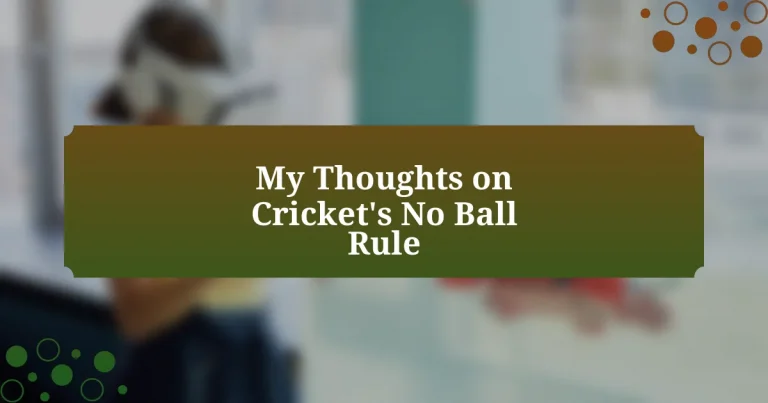Key takeaways:
- No balls can shift game momentum, introducing pressure that affects both teams and individual players.
- Teaching kids about no balls can enhance their understanding of cricket and promote strategic thinking.
- Common misunderstandings about no balls can lead to confusion among young players, highlighting the importance of clarity in rules.
- No balls are more frequent in professional games than many young players realize, underscoring the significance of maintaining focus as a bowler.
How No Ball Affects Game
No balls can dramatically shift the momentum of a game. I remember a match where a key bowler overstepped, giving away a free hit, and the opposing team capitalized on it. It was exhilarating to watch the batsman smash boundaries, but as a fan, I felt a mix of excitement and frustration—how could one misstep change the tide so quickly?
The emotional impact of a no ball goes beyond just statistics; it introduces a layer of pressure that both teams must navigate. Picture a tense game where every run counts, and suddenly a no ball turns a crucial moment into a golden opportunity for the batting side. Doesn’t it make you wonder how much a single mistake can haunt a bowler throughout the match?
Finally, from a player’s perspective, the no ball rule serves as a constant reminder to maintain focus. I’ve seen bowlers who, after a no ball, struggle to regain their rhythm, leaving them vulnerable. This internal battle can be challenging, and it’s that pressure cooker environment that makes cricket not just a game of skill, but also a mental challenge. How do you think you would handle that kind of intensity on the field?
Teaching Kids About No Ball
Teaching kids about the no ball rule can be both fun and enlightening. I remember teaching my younger sibling how a bowler’s foot placement can affect the game. It was a light-hearted moment when I showed them how easy it is to overstep, and we both laughed about it while practicing some bowling in our backyard.
Sometimes, a no ball can easily catch a child’s attention. I’ve noticed that when I explain the idea of a “free hit,” their eyes light up with curiosity. It’s an exciting concept for them—a chance to step up and hit the ball without the fear of getting out. This opens up a discussion about strategy and opportunity, leading to deeper conversations about gameplay and decision-making.
Encouraging kids to ask questions about the rules can also enhance their understanding of cricket as a whole. I often ask, “What would you do if you were the batsman in this situation?” Their imaginative answers not only show how engaged they are, but it also empowers them to think critically about the game. This interactive approach fosters a sense of ownership over the rules, making each lesson a memorable experience.
Common Misunderstandings of No Ball
Many young players often think that a no ball is just a minor mistake, but it can actually alter the game significantly. I remember when my friend was bowling in a school match, he was frustrated after being called for a no ball, believing it didn’t affect anyone much. However, I pointed out how it gave the batting team an extra run and the chance for an easy hit—he quickly realized the gravity of such a seemingly small error.
Another common misunderstanding I’ve observed is that some kids believe a no ball means an automatic run out for the bowler. I recall explaining to my team during practice that a run out is only possible under specific conditions and that the no ball rule mostly benefits the batting side. This confusion can lead to unnecessary pressure on young bowlers, so it’s essential to clarify these points.
Some children also mistakenly think a no ball rarely happens in professional games. From my experience watching matches, even elite bowlers overstep or don’t deliver properly on occasion. The reality is that understanding the nuances of the no ball can help kids appreciate the sport more deeply. Have you ever seen a bowler lose their rhythm because of a no ball? It’s a reminder that every moment in cricket counts.


